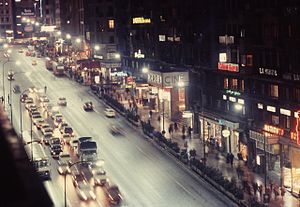Impact of the Franco and Postfranco Years on Free Expression and Art

Madrid at night, photograph by Paolo Monti. The Movida people coined the now famous war-cries of the city: Madrid nunca duerme ("Madrid never sleeps"), Esta noche todo el mundo a la calle ("Tonight everybody to the street") or Madrid me mata ("Madrid kills me").
La Movida Madrileña (English: The Madrilenian Scene) was a countercultural movement that took identify mainly in Madrid during the Spanish transition to democracy afterwards the expiry of dictator Francisco Franco in 1975.[i] The movement coincided with economic growth in Spain[ citation needed ] and a widespread desire for the development of a mail service-Francoist identity.[i] The Concierto homenaje a Canito (Canito Memorial Concert), which took identify on February ix, 1980, is traditionally considered the offset of La Movida Madrileña.[ane]
La Movida Madrileña featured a rise in punk stone and synth-pop music, an openness regarding sexual expression and drug usage, and the emergence of new dialects such as cheli.[i] This hedonistic cultural wave started in Madrid before appearing in other Spanish cities such equally Barcelona, Bilbao and Vigo.[ citation needed ]
Origins [edit]
In the years post-obit the death of Francisco Franco, a growing hole-and-corner punk rock music scene began to course in Madrid.[i] Inspired past the growth of punk rock in the United kingdom of great britain and northern ireland, a number of punk and synthpop bands, such as Tos and Aviador Dro,[i] formed in the late 1970s. However, this new counterculture clashed heavily with the Castilian national government, which mandated an evening curfew for women, criminalized homosexuality, and arrested people with unorthodox appearances for violating a law regarding "dangerousness and social rehabilitation".[1]
La Movida Madrileña gained notoriety following a big punk concert at the Technical University of Madrid on February nine, 1980.[1] Although Francoist elements connected to oppose the increasing liberalization of the metropolis, the government under socialist mayor Enrique Tierno Galván had a more open approach regarding the movement, and subsidized diverse creative endeavours.[i] A number of influential strange artists, such equally the Ramones and Andy Warhol, visited Madrid during this time.[2]
Characteristics [edit]
La Movida Madrileña's central component was an aesthetic influenced by punk rock and synth-pop music, equally well equally visual schools such every bit dada and futurism.[1] The aesthetic permeated into the city's street mode, photography, cartoons, and murals,[1] manifesting itself in bright colours, voluminous hair, unconventional and revealing clothing, and heavy makeup use among all genders.[ii]
In addition to these artistic representations, La Movida Madrileña as well effected an emergent LGBTQ+ community, illicit drug employ, and the use of the cheli dialect.[1]
Although some people involved with the move testified to a lack of a unified political ideology, many elements of the movement were antifascist and had agitator leanings.[i]
Representatives [edit]
The Movida comprised many art movements; Pedro Almodóvar became a well-known instance internationally after his success as a film director.[1] [2]
Music [edit]
In moods, looks and attitude, the sound resembled the British punk and new wave scenes and the Neue Deutsche Welle, sometimes (in the case of Mecano) mimicking styles such as New Romantic.[ citation needed ]
Picture show and tv [edit]
Almodóvar comically reflected the messiness of the liberty of those years, particularly in his films Pepi, Luci, Bom y otras chicas del montón;[one] Laberinto de pasiones;[ citation needed ] and What Have I Done to Deserve this? (1984).[ citation needed ]
Television set programs like La Bola de Cristal and La Edad de Oro contributed to spread the aesthetics of the motion to a wider audience.[ commendation needed ]
Photography and painting [edit]
Lensman Gorka de Duo accompanied Warhol and had an exhibition with Robert Mapplethorpe in the Fernando Vijande gallery.[ citation needed ]
Graffiti [edit]
Artists like Muelle created a unique class of street art, later described as "graffiti autóctono madrileño".[3]
Literature [edit]
Writers Gregorio Morales, Vicente Molina Foix, Luis Antonio de Villena, Javier Barquín, José Tono Martínez, Luis Mateo Díez, José Antonio Gabriel y Galán, José Luis Moreno-Ruiz and Ramón Mayrata were prominent in the "Tertulia de Creadores", which were a bicycle of meetings, lectures, debates and happenings that took identify in the Círculo de Bellas Artes in Madrid between 1983 and 1984.[ citation needed ] Many of them, as Gregorio Morales, José Tono Martínez or Ramón Mayrata, were regular collaborators of the art mag La luna de Madrid. Other publications, such as Oscar Mariné'due south magazine Madrid Me Mata (Madrid Kills Me) contributed to the creation of a common identity.[ commendation needed ]
Some other of import figure outside the artistic world of the Movida was announcer Francisco Umbral, a writer for the newspaper El País, who wrote about and documented the movement.[ citation needed ]
Run into also [edit]
- Movida viguesa
References [edit]
- ^ a b c d e f g h i j k l m n o Phelan, Stephen (2020-02-11). "'Bless the chaos': La Movida Madrileña, Spain's seedy, wild mail service-Franco hugger-mugger". The Guardian. Archived from the original on 2021-05-04. Retrieved 2021-05-04 .
- ^ a b c Dickson, Andrew. "Kingdom of spain'due south wild party subsequently Fascism". www.bbc.com. BBC. Archived from the original on 2021-05-04. Retrieved 2021-05-04 .
- ^ Zaino, Lori (26 May 2017). "Meet Muelle, Madrid'southward About Famous Grafitti Artist". Civilization Trip . Retrieved 2021-09-08 .
External links [edit]
- Photogallery of the photograph Gorka De Duo
whiteheadprucestras.blogspot.com
Source: https://en.wikipedia.org/wiki/La_Movida_Madrile%C3%B1a
0 Response to "Impact of the Franco and Postfranco Years on Free Expression and Art"
Publicar un comentario